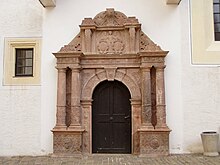
Back Candaliello AN حجر العقد Arabic Açardaşı Azerbaijani Замковы камень Byelorussian Ключов камък Bulgarian শিরকোণ (স্থাপত্য) Bengali/Bangla Clau de volta Catalan Svorník Czech Schlussstein German Σφηνόλιθος Greek


A keystone (or capstone) is the wedge-shaped stone at the apex of a masonry arch or typically round-shaped one at the apex of a vault. In both cases it is the final piece placed during construction and locks all the stones into position, allowing the arch or vault to bear weight.[1][2][3] In arches and vaults (such as quasi-domes) keystones are often enlarged beyond the structural requirements and decorated. A variant in domes and crowning vaults is a lantern. A portion of the arch surrounding the keystone is called a crown.[4]
Keystones or their suggested form are sometimes placed for decorative effect in the centre of the flat top of doors, recesses and windows, so as to form an upward projection of a lintel, as a hallmark of strength or good architecture.
Although a masonry arch or vault cannot be self-supporting until the keystone is placed, the keystone experiences the least stress of any of the voussoirs, due to its position at the apex.[citation needed] Old keystones can decay due to vibration, a condition known as bald arch.
- ^ Ching, Francis D.K. (1995). A Visual Dictionary of Architecture. New York: John Wiley & Sons, Inc. p. 12. ISBN 0-471-28451-3.
- ^ "Glossary of Medieval Art and Architecture – Keystone". University of Pittsburgh. Retrieved 2007-06-25.
- ^ "keystone". Merriam Webster. Retrieved 2007-06-25.
- ^ Wilkins 1879, p. 292.
© MMXXIII Rich X Search. We shall prevail. All rights reserved. Rich X Search